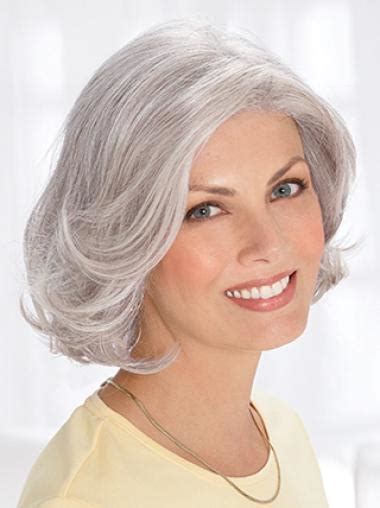As women age, their hair may undergo changes in texture, volume, and color. These changes can be a natural part of aging, but they can also affect self-esteem and confidence. Wigs offer a non-invasive solution to these hair-related concerns, allowing elderly women to embrace their desired look and feel more comfortable in their skin.

Benefits of Wigs for Elderly Women
- Enhances Confidence: A well-fitted wig can boost self-confidence by concealing hair loss or thinning, giving elderly women a more youthful and vibrant appearance.
- Provides Comfort: Wigs can provide thermal insulation, protecting elderly women from cold temperatures and reducing the need for bulky head coverings.
- Facilitates Hair Styling: Wigs allow elderly women to experiment with different hairstyles and colors without damaging their natural hair.
- Promotes Socialization: A stylish wig can enhance social interaction by making elderly women feel more confident in public settings.
- Supports Hair Growth: Contrary to popular belief, wigs can actually promote hair growth by preventing friction on the scalp and providing a protective layer.
Choosing the Right Wig
Selecting the right wig for elderly women is crucial to ensure comfort, style, and a natural appearance. Here are a few factors to consider:
- Hair Type: Choose a wig with a hair type that closely matches the texture of the natural hair.
- Wig Cap: Opt for a wig cap made of breathable materials, such as lace or mesh, to minimize itching and discomfort.
- Lace Front: A wig with a lace front creates a seamless transition between the hairline and the scalp, providing a more realistic appearance.
- Color: Select a wig color that complements the skin tone and matches the natural hair color, if possible.
- Personal Style: Consider the individual’s personal style and preferences when choosing the wig’s length, volume, and cut.
Types of Wigs
There are various types of wigs available for elderly women, each offering unique benefits and features.
- Synthetic Wigs: Made from artificial fibers, synthetic wigs are affordable and easy to maintain. However, they may not be as breathable or realistic as human hair wigs.
- Human Hair Wigs: Crafted from real human hair, these wigs provide the most natural appearance and feel. They are more expensive than synthetic wigs and require regular maintenance.
- Custom Wigs: Custom wigs are tailored to the individual’s head shape and size, ensuring a perfect fit and maximum comfort.
- Monofilament Wigs: These wigs feature a fine mesh cap that provides breathability and allows for a natural-looking scalp appearance.
- Heat-Resistant Wigs: Heat-resistant wigs can be styled with heat tools, giving elderly women more versatility in their hairstyle.
Care and Maintenance for Wigs
Proper care and maintenance are essential to extend the lifespan and preserve the quality of wigs. Here are some tips for wig care:
- Regular Washing: Wash the wig gently with cold water and a mild shampoo.
- Conditioning: Condition the wig every few washes to keep it soft and manageable.
- Drying: Air-dry the wig on a wig stand or use a low heat setting on a hair dryer.
- Storing: Store the wig in a cool, dry place protected from direct sunlight.
- Brushing: Brush the wig gently with a wide-toothed comb to prevent tangles.
Frequently Asked Questions (FAQs)
-
Can I wear a wig with my own hair?
Yes, it is possible to wear a wig over natural hair, but it is important to secure the wig properly to prevent it from slipping. Consider using a wig cap to create a smooth base and keep your own hair in place. -
How often should I replace my wig?
The lifespan of a wig depends on the type of wig, the frequency of wear, and the care it receives. On average, synthetic wigs last 6-12 months, while human hair wigs can last 1-2 years with proper maintenance. -
How do I adjust the size of my wig?
Most wigs come with adjustable straps or clips that allow you to customize the fit. Consult the wig’s manufacturer instructions for specific guidance. -
Can I swim with a wig?
Swimming with a wig is not recommended as chlorine and salt water can damage the hair fibers. However, some heat-resistant wigs are designed to withstand limited water exposure. Always check with the wig manufacturer before swimming. -
How do I style my wig?
Wigs can be styled with heat tools, such as curling irons and flat irons, provided they are heat-resistant. Be sure to use a heat protectant spray to prevent damage. -
Can I cut my wig?
Cutting a wig is possible, but it is important to consider the wig’s construction. Synthetic wigs can be trimmed, while human hair wigs may require a professional cut. Consult a wig specialist for guidance. -
How do I clean the inside of my wig?
To clean the inside of your wig, gently wipe it with a damp cloth and a mild cleanser. Avoid using harsh chemicals or abrasive cleaners. -
Can I dye my wig?
Dyeing a wig is possible, but it is recommended to seek professional assistance to avoid damaging the hair fibers. Only use hair dyes specifically designed for wigs.
